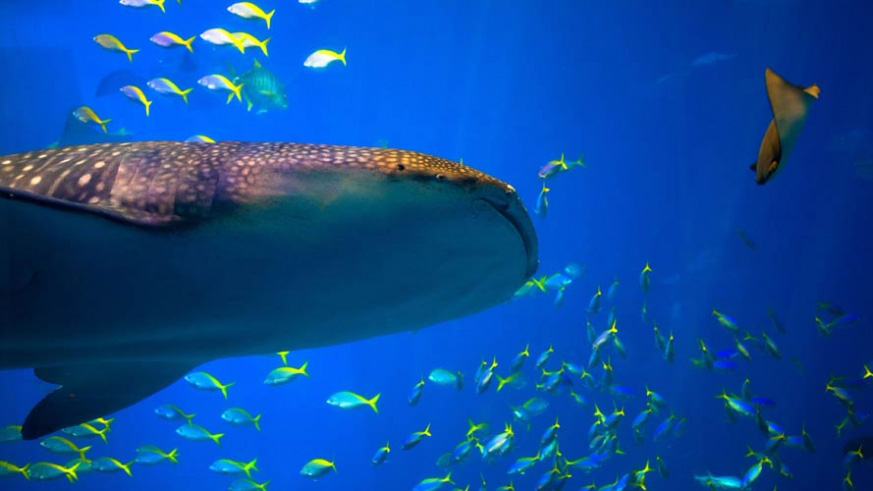– by Capt. Pat Rains
Chill Out this Summer in the Coolest Dive Spots around the Sea of Cortez
Access to remote places is one of the coolest advantages of boat ownership. So, while land-based folks are sweating through summer, we can cool off in a few of the most interesting dive spots that are accessible only by boat.
Because August and September are the height of summer storm season in Mexico, let’s look at remote dive spots near hurricane holes in the Sea of Cortez, which Jacques Cousteau dubbed the Aquarium of the World.
GEARED UP?
Whether you’re doing some serious scuba diving or just snorkeling around the boat for a few minutes, first give all your dive gear a summer safety check. When’s the last time your scuba tanks were inspected? Are they full now? Did you flush the sand and salt water out of your regulator with fresh water before stowing it last time? If not, flush it now. Do your need to replace some worn out straps on your fins, masks and snorkel tubes?
Is your boat’s swim step or ladder ready for divers to get in and out safely? Is your dinghy easy to board, or do you need to hang a rope ladder? Got plenty of water proof sun block?
Bigger boats are likely to carry some scuba gear – maybe even a compressor – as safety gear for making emergency DIY bottom repairs. Since that’s often the original excuse for the investment, you may as well “limber it up” for recreational pleasure, just in case.
What about wet suits? Sea of Cortez coastal waters are usually warm enough in summer that a full-body neoprene wet suit is over kill. But the added floatation of even a “shorty” wet suit (shorts and short-sleeved or tank top) will benefit children, elders and novice swimmers. A long-sleeved T-shirt over a swim suit prevents sun burn. Protect your tender tootsies with booties.
CHECK IT OUT
Whenever exploring a new dive location, an easy way to check it out is to anchor nearby and snorkel over it first to see what catches your eye. Or take the dinghy around a few corners, anchor the dink off the nearest beach and snorkel around to determine if conditions are favorable and it looks inviting. If you see any jelly fish, just move on. Remember to shuffle your feet in beach sand to scare away any sleeping sting rays.
I’d like to avoid the tourist-heavy locations, so let’s look at just the most interesting boater-only dive spots that are within a day’s sail from the hurricane holes of La Paz, Puerto Escondido, the Midriff Islands, L.A. Bay and San Carlos.
LA PAZ
Boaters can anchor in El Empachado Cove on the southwest side of Isla Espiritu Santo to dive the wreck of the Fang Ming, the 185-foot steel-hulled Chinese smuggling vessel seized with 88 men and seven women in confinement. Fang Ming was sunk in 1999 a quarter mile west of this cove, sitting on the sand bottom in 69 feet, attracting lots of marine life.
Dive through the “Garden in the Sea,” a sculptural grouping submerged in 2017 off the north side of Monument Rock in the middle of Caleta Candelero. This environmental project shows how quickly marine flora and fauna thrive. But don’t anchor atop the sculptures: 24° 30’18”N, 110°23’25”W.
PUERTO ESCONDIDO
Isla Danzante carries a nav light on its south end to mark a lovely linear reef stretching less than a quarter mile southeast. Danzante Reef’s near shore half is often breaking, so you’ll dive the south half, which looks like a ship’s bulbous bow or an older submarine surfacing. Current and upwellings bring nutrients to the colorful sea life on Danzante Reef. One mile northeast is Danzante Arch, seldom visited by tourists.
Danzante Reef is less than five miles from Marina Puerto Escondido. The nearest anchorage is Honeymoon Cove (Luna de Miel) on Danzante’s northwest quadrant.
Alternately, V Cove on the north side of Carmen Island is a unique dive excursion reserved for summer. Here you’ll find a sea-level cave that’s roomy enough to enter with your dinghy, SUP or kayak, and at low tide you can land on a small beach at the cave’s far end. V Cove is about 1.75 miles southwest of Punta Lobos, the bold NE tip of Carmen Island.
During hurricane season, boaters keeping a close eye on the weather can roam freely around the upper Sea of Cortez.
MIDRIFF ISLANDS
Bahia San Francisquito on Baja is one of the most remote places on earth, yet logistically it’s a primo departure anchorage for the easy 60-mile crossing of the Sea of Cortez with the Midriff Islands always in site.
By anchoring in Bahia San Francisquito you can snorkel the lushly cloaked rock piles on the east side of Punta Mujeres, the bay’s northwest corner. These piles are rife with tall lacey fans and brilliant reef fish. Also, you can dinghy around that corner to snorkel off the pristine white beaches in two tiny coves known as Caleta Ninos and Caleta Mujeres.
On the east side of Isla San Esteban (about half way across), a small volcanic islet with dramatic 80 feet peaks stretches its reef fingers 300 yards northeast and southwest. This reef (one mile northeast of the island’s rounded southeast corner) pokes out perpendicular from the south end of Playa Arroyo anchorage. You can walk down the beach and swim right out over the reefs at either end of the islet. Sea life here is incredibly rich, because the whole Sea of Cortez ebbs and flows around Isla San Esteban.
Monument Pass (35 to 50 feet depths) at the south tip of Isla Tiburon (largest island in the Sea of Cortez) offers expert diving in three spots: a rock reef that runs north from Isla Chayudito (Little Knob), a longer deeper reef that links Chayudito to Chayudo, and all around Isla Turner. The west side of Monument Pass drops off to 900 foot depths, while the east side forms a 30- to 60-foot shelf. Expect strong tidal current, whale sharks and schools of manta rays. The nearest summer anchorage is at Tiburon’s Dogs Bay, five miles northeast of Monument Pass.
L.A. BAY
From the hurricane hole of Puerto Don Juan near Bahia de Los Angeles, you have 17 separate islands running north for 10 miles, providing half a dozen intimate dive spots. Of those, my favorite is Ventana Reef (15 to 35 feet depth) running southeast from Isla Ventana.
If you’re hunkered down in Puerto Refugio at the north end of Guardian Angel Island, the two best dive spots are False Pass at the south tip of Isla Division and Isla Piedra Blanca in the middle of Refugio’s East Bay.
SAN CARLOS
From the summer shelter of San Carlos, Sonora, boaters can zoom 15 miles west to Isla San Pedro Nolasco where hammer head sharks gather for their annual mating rendezvous in August, while some stick around through November. La Cueva on the island’s southeast flank has a good cave dive. If you’re exploring north up the coast, primo diving reefs are found at Himalaya, Venazia and Seri Muerto Cove.







